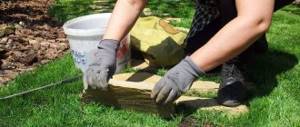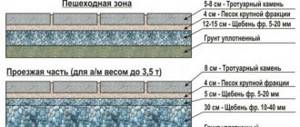At the summer cottage, paths are created that are convenient for the movement of garden equipment, small paths that provide access to all areas of the garden. Paths in the countryside made of paving slabs have the necessary unitary properties, they are convenient and quick to install, and if desired, they can be quickly disassembled and repaired - replace one tile with another.
Paving slabs are a modern material for arranging paths in a suburban area
Basic rules and common mistakes when choosing paving slabs
The possible load is determined before purchasing material for paving paths; each paving slab has its own strength. If the coating thickness does not correspond to the expected load; type of foundation, cracks and fractures will quickly appear. Stone, clinker and concrete tiles are laid on a dense base up to 20 cm thick, depending on the soil. Such materials are susceptible to seasonal soil heaving. The flexible plastic is thrown directly onto the grass.
The result of poor preparation of the base for paving slabs
Destruction of low-quality tiles under the influence of water and frost
If you buy low-quality tiles, you will not get a good result either. When making concrete paving stones or shaped tiles yourself, you need to choose the right brand of cement. Of the finished products, concrete and stone paving coverings have high strength indicators. Ceramics and porcelain stoneware require careful preparation of the base. The right material for any type of installation will last for many years and will make movement around the garden convenient and comfortable.
Construction of a garden path from paving slabs
In flooded areas where melt and rainwater accumulate, drainage is necessary to prevent puddles from appearing on the paths.
How to choose paving slabs for your dacha
is of great importance . When purchasing, you should pay attention to the label, which indicates the composition of the solution and production technology.
To select a tile, you need to determine where it will be laid. If this is a place for a car to enter, then vibro-pressed tiles with a thickness of 4.5 cm are better suited.
Cast tiles are great for laying garden paths in smaller areas with less traffic. Its thickness must be at least 3 cm.
Recent Entries
Chainsaw or electric saw - what to choose for the garden? 4 mistakes when growing tomatoes in pots that almost all housewives make Secrets of growing seedlings from the Japanese, who are very sensitive to the soil
The external parameters of the tiles may vary significantly. Decide whether you need a smooth or rough surface. The color can be oversaturated with cheap dyes , which over time make the surface friable. To check the quality of the material, you can conduct a small experiment. To do this, you need to hit two blocks together. If the sound is clear, then the tile is of high quality; if it is dull, then various mixtures were added to the solution.
When purchasing tiles, inspect the entire tile. If there are stains on the outside, then sand and clay were added during manufacturing. The tile may have a heterogeneous composition. To check this, you should split it and see if it has any clots, etc.
If an aesthetic appearance, a variety of geometric shapes and colors are important to you, then you should choose cast tiles. If longevity is important, then pressed tiles would be the optimal and best option.
Choice of material - types of tiles
For paving garden passages, materials are chosen depending on the traffic flow. For wide paths where vehicles can pass, durable coatings are needed. Narrow paths are decorated with light tiles.
The highest quality and most durable path - bounded on both sides by curbs pre-installed on the concrete mixture
A natural stone
Stone garden paths are a classic. The stone will fit into any landscape design, it all depends on the shape and color of the stone:
- durable granite with a variety of textures is offered in the form of tiles and bricks;
- marble amazes with its variety of shades, most often used in the form of natural cuts of blocks;
- The choice of slate for installation is hard, quartzite, the palette of shades is wide from gray to marsh, pinkish-salmon to carmine;
- quartzite is harder than slate, rougher, cut into tiles or paving stones;
- shungite is smooth, smooth, gray like asphalt, sometimes there are pieces with shiny quartz veins;
- sandstone is cut into bars and tiles of various formats, moisture saturation is higher than that of other stones, but it is very decorative, the rough texture creates an anti-slip effect;
- flagstone is quartz rocks that form layered deposits, textured, yellow to reddish in color.
Stone tiles with a relief surface look elegant and expensive
A combination of stones with a rough and smooth surface is allowed. The best option is the joint laying of sandstone and marble.
Fake diamond
For paving stone paths in the country, clinker bricks and concrete tiles are used. Clinker is made from plastic clay, looks like a solid brick, and comes in shades of brown and red-brown.
Clinker paving stones are one of the most durable materials for country paths
Porcelain tiles vary in texture, color, and are produced:
- in the form of tiles of various formats;
- torn plates imitating natural pieces of stone.
Most often you can find porcelain tiles in medium and large formats
Garden path made of porcelain tiles with imitation of natural stone
When working with flagstone, it is recommended to install curbs on paths after laying to reduce the number of trims.
Concrete
The concrete is made smooth or with an anti-slip surface (the hardening concrete is treated with sand). They imitate the texture of flagstone and clinker. Concrete paths made of tiles in the country are an economical design option. When making fragments yourself, ready-made molds are used.
Concrete tiles are produced in different sizes, textures and thicknesses
When making it yourself, concrete tiles are poured directly on site
Polymers and plastics
Modern manufacturers offer many types of decking - artificial deck boards or parquet. Paths made from such tiles look like wooden flooring and are not afraid of moisture or temperature contrast.
Garden decking or parquet are panels with a pattern made from a mixture of plastic and wood flour.
Plastic covering made of modules is suitable for constructing paths and decorating recreation areas
Lawn tile gratings are created in the form of modules; they are usually green, easy to install, and will preserve the green carpet.
A path made of plastic lattice can be made directly through the lawn, or it can be laid on a sand bed and the cells can be filled with fine gravel.
Choosing a material or slab for paths in the country
You should choose slabs and flagstones for paving paths based on the width of your garden paths. Typically the width varies from half a meter to two meters. If you decide to use layers of natural stone, then flagstone is ideal for you - a durable material with a natural, distinctive pattern and unique style. You still have to design a path, whether you like it or not. You will need to prepare the trench and lay a special pad, and then deal with the final layer. In a step-by-step version it looks like this:
Drawings for laying paving slabs and paving stones - design solutions
There are several types of paving; installation technology is chosen depending on several factors:
- relief features;
- the width and contour of the path, on a wide one you can create large mosaic designs, on winding ones, chaotic laying is appropriate;
- architectural features of buildings located on the site;
- purpose of the zone being designed.
Using paving slabs, you can make paths with unusual patterns, different colors and textures
Manufacturers produce tiles in various sizes:
- square;
- hexagonal;
- in the form of fish scales;
- rectangular - this shape is considered traditional.
Paving slabs are convenient to use both on narrow paths and for paving large areas
Paving the recreation area with large-format natural stone tiles
Combining different tiles allows you to create beautiful patterns on garden paths
Patterns are created by alternating the position of the tiles, using coatings of various colors and sizes.
Errors when marking the area for tile laying lead to an increase in the consumption of coatings. The number of tiles that need to be cut increases.
Typical installation options with step-by-step instructions can be easily found on the Internet:
- Direct laying is the formation of narrow strips that set the direction of movement. In rows, the seams are combined with adjacent ones or made with a shift of half or 1/3 of the tile.
- “Herringbone” - installation of covering fragments at an angle, one of the popular methods of paving paving stones, clinker bricks (by changing the angle of the “herringbone”, the width and length of the path are visually adjusted).
- A chaotic laying order is welcome if the tiles in the packs do not match in shade (before installing the covering, it is recommended to open all purchased packages, only then begin laying).
- “Checkerboard” – alternating light and dark fragments. For chessboard, tiles of any shape are used, the main thing is that they match in size.
- Diamonds are created for visualization; they can lengthen and shorten the sidewalk.
- Circles and segments are formed by radial laying; colored square tiles look especially decorative.
- The curly ones are laid out according to a prepared template, and interesting images of birds and animals, intricate patterns, and ornaments are obtained.
Path made of clinker bricks laid in a herringbone pattern
Garden paths laid out with rectangular tiles “staggered”
Working with natural stone, selecting pieces to fit the format of the path, sawing off or chipping the excess. If desired, smooth the sharp corners of the stone with a grinding machine. The fragments are laid end-to-end or with a gap filled with sand or concrete mortar with the addition of dyes. For whiteness, fluff is added, shades of gray are created with ash. You can add water-based or acrylic paint colors to concrete.
The trend is zoning using a combination of natural paving with other types of coatings; transitions are decorated with different green spaces that complement the unified picture of the landscape.
Types of paths, or what is the best tile for paths in the garden
Any tile for garden paths must be durable and wear-resistant, otherwise the beautifully paved but cheap material will simply become unusable in a short time. Those that belong to the main ones must be monumental and bear a heavy load. Secondary ones can be created from stone, pebbles, asphalt - as you like. Those paths that are used extremely rarely can be left completely unpaved or replaced with a step-by-step option. Of course, you can choose wood as the main material, and use wood sawdust to create a decorative style. But you most likely will not be able to avoid the rotting process.
Natural stone is used in different styles. Granite, marble, limestone and sandstone are especially in demand. But often the price for these types of products (especially the first ones) is very high. And in winter there is a real chance of slipping on ice-covered stones. Clinker brick is also durable and is used more often to design paths. It also looks beautiful as a border decoration. The brick is easy to install and at the same time it is compatible with different materials when laying.
Artificial surfaces such as concrete or plastic tiles are also gaining market share. Without mortar, you can install such tiles directly on the ground without any problems. And its wear resistance, thanks to new technologies, will also be at the same level. Whatever option you choose, proceed from the style that already exists on your site - it is better that the design of the garden paths does not clash with the decoration of the buildings on your site. Don't reinvent the bicycle - the path must be durable, easy to maintain, and the material must be wear-resistant. So you have everything in your hands - choose what you like best: paving stones, rock stones, granite bars, rubble stone, slate, sandstone, clinker bricks, paving slabs, pebbles, wood, ceramic tiles or, perhaps, nothing at all concrete plates.
Photo examples of beautiful garden paths made of tiles and paving stones
The shape and width of garden paths depends on the surroundings. In English gardens, the shape of garden paths made of paving stones or ceramics is arbitrary, with expansions and contractions. More often they choose hexagon and scale tiles, which create smooth lines and an original pattern. Beautiful mosaics are created from clinker bars of various shades and colored concrete.
Path made of hexagonal tiles of different shades
Natural stone always looks luxurious. Untreated flagstone or layered stone create a colorful texture in French formal gardens and often appear in fantasy landscape projects. The elements are laid end-to-end, the gaps filled with tinted concrete add color and emphasize the natural beauty of the stone.
Stone tiles on a summer cottage in fusion style
Garden paths made of figured concrete, decorated with shards, glass shards, and boring jewelry, are always individual and speak about the taste of the owners of the estate. Working with figured tiles is more difficult, but you get very interesting designs.
Paving slabs with a decorative coating of colored pebbles
Vibro-cast paving slabs in bright colors
The front path will decorate the facade. A winding path between tree trunks or flower beds will visually enlarge the area and create the illusion of space. You can make your garden more beautiful with any type of coating, the main thing is that the tiles fit harmoniously into the landscape.
The front path, laid out with a beautiful pattern, will adequately decorate the entrance area in a suburban area











